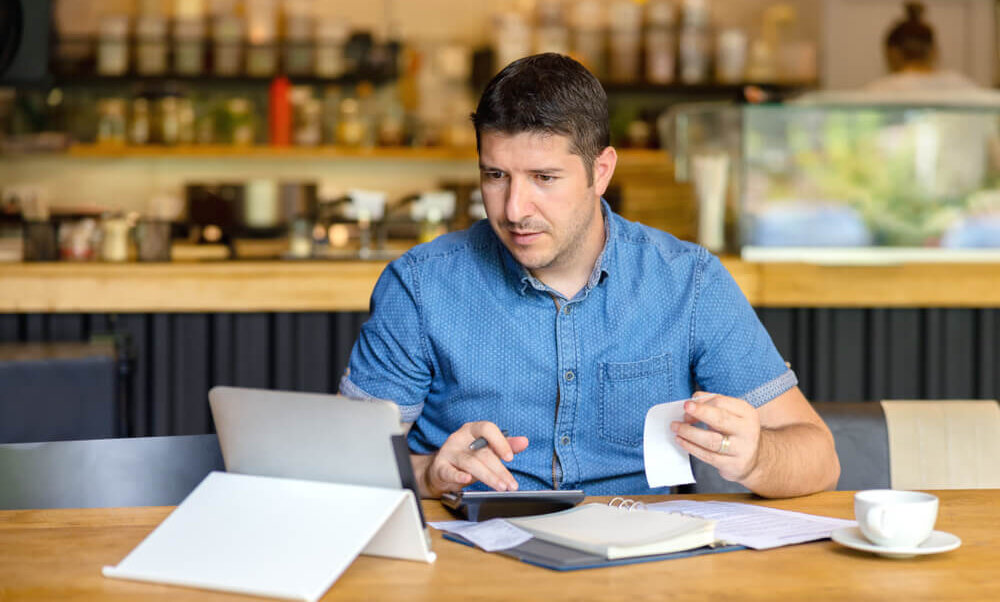Understanding how to calculate Value Added Tax (VAT) is essential for businesses registered for VAT in the UK. VAT is a tax that customers pay on most goods and services, with businesses acting as collectors for the government.
To calculate VAT, you need to determine the percentage based on the total taxable value, which includes the cost of goods or services and applicable VAT rates. Accurate VAT calculations ensure your business is compliant with tax regulations and helps to keep it on track.
When do I have to calculate VAT?
As a business in the UK, you must calculate VAT when buying or selling goods and services. Here are some examples of when you’ll need to calculate VAT:
- Sales – When you sell products or services as a VAT-registered business, you must calculate the VAT you will charge your customers.
- Purchases – When you buy products or services on behalf of your business, you must calculate the VAT included in the purchase price.
- VAT Returns – VAT-registered businesses must file Making Tax Digital (MTD) returns to ensure accurate VAT calculations and improve compliance.
What is the VAT rate in the UK?
The current standard VAT rate in the UK is 20%, which means most products and services are subject to this rate. The standard VAT rate applies to a broad range of goods and services, including consumer items, electronics, furniture, clothing and non-essential services. However, certain items qualify for reduced VAT rates. For example, children’s car seats and home energy are subject to a reduced rate of 5%. Some items are zero rated (0%), such as most food items and children’s clothes. As VAT rates are subject to change, keeping track of any adjustments ensures your calculations remain accurate and compliant.
How to calculate VAT?
In the UK, understanding how to calculate VAT is crucial for businesses. Whether you need to add or remove VAT, accurate calculations ensure you remain compliant. Here are some examples of how to calculate VAT:
Adding VAT
To add VAT to an amount or price, multiply the VAT rate by the original amount and add the result to the original amount. For example, let’s say you have a product priced at £200 (without VAT) and a VAT rate of 20%:
- Multiply the original amount by the VAT rate (£200 x 1.2 (20%) = £40)
- Add the VAT amount to the original amount (£200 + £40 = £240)
By adding 20% VAT to the original amount of £200 with a 20% VAT rate, the total price, including VAT, is £240.
Removing VAT
To remove VAT from an amount, you need to divide the original figure by 100 plus the VAT percentage, for example, 120 for a 20% VAT rate, and multiply the result by 100. Here we’ll use an example of removing 20% VAT from £200:
- Divide the amount by 100+20, multiply the result by 100 (£200 ÷ 120 x 100)
Removing 20% from the VAT-inclusive figure of £200 leaves you with approximately £166.67.
Reduced Rate VAT
A similar approach is required for the reduced rate of VAT. The VAT fraction is 1/21 and to work out 5% VAT from a gross (VAT inclusive) amount, you take the gross amount £105 x 1 divided by 21 = £5 VAT and £100 net.
One other point to note, zero rate is a rate of VAT and whilst to the customer it might look like VAT has not been charged, it is important from an invoicing perspective that if you make a zero rated supply, that you do charge VAT, albeit at 0% because 0% VAT is very different to exempt supplies (such as healthcare and education) and outside the scope of VAT (usually seen when making supplies of services to overseas business customers).
What are VAT invoices?
VAT invoices are a type of invoice that tells customers the amount of VAT they’ve paid on their purchase. If your business is VAT registered, you must issue VAT invoices. They enable some customers to claim VAT back. VAT invoices provide evidence of the transaction and provide important details for accounting and tax purposes. They typically include the seller’s and buyer’s details, a unique invoice number, the date of the transaction and a description of the goods or services purchased. VAT invoices also include the VAT rate applied, the amount of VAT charged and the total amount payable.
There may be scenarios where the invoice contains supplies which carry different VAT rates, for example, a business may buy wholesale children’s clothing but also adult clothing and the supplier will need to show the different VAT rates that are applicable (0% and 20% respectively in this example) and there may be other complications with mixed supplies such as seen when buying a typical supermarket meal deal which may consist of standard rated items (drink, crisps) and zero rated items (the sandwich salad) but which are sold as a single “deal”, there are special rules on how to approach the calculation of VAT in these instances.
Get in touch
Calculating VAT is a crucial part of running a business. Understanding how to work out vat and the different rates ensures you make accurate calculations and that you remain compliant in line with tax regulations. To learn how we can help with your VAT obligations, speak to one of our VAT accountants today.


Sign up to our newsletter
Join our mailing list to receive regular updates on
the news and events you need to know about.

